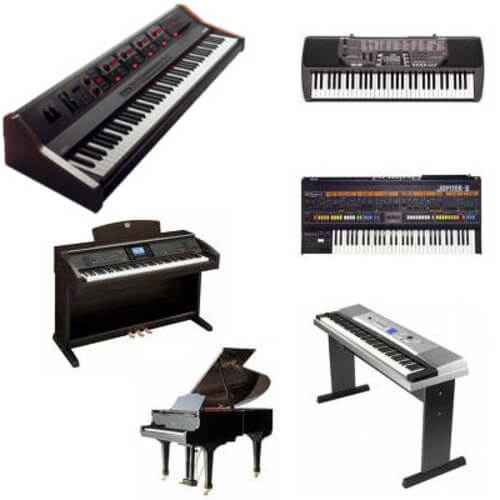Electronic Instruments
 Electronic instrument, any musical instrument that produces or modifies sounds by electric, and usually electronic, means. The electronic element in such music is determined by the composer, and the sounds themselves are made or changed electronically. Instruments such as the electric guitar that generate sound by acoustic or mechanical means but that amplify the sound electrically or electronically are also considered electronic instruments. Their construction and resulting sound, however, are usually relatively similar to those of their nonelectronic counterparts.
Electronic instrument, any musical instrument that produces or modifies sounds by electric, and usually electronic, means. The electronic element in such music is determined by the composer, and the sounds themselves are made or changed electronically. Instruments such as the electric guitar that generate sound by acoustic or mechanical means but that amplify the sound electrically or electronically are also considered electronic instruments. Their construction and resulting sound, however, are usually relatively similar to those of their nonelectronic counterparts.
Electricity was used in the design of musical instruments as early as 1761, when J.B. Delaborde of Paris invented an electric harpsichord. Experimental instruments incorporating solenoids, motors, and other electromechanical elements continued to be invented throughout the 19th century. One of the earliest instruments to generate musical tones by purely electric means was William Duddell’s singing arc, in which the rate of pulsation of an exposed electric arc was determined by a resonant circuit consisting of an inductor and a capacitor.
The dawn of electronic technology was marked by the invention of the triode vacuum tube in 1906 by Lee De Forest. The triode gave musical instrument developers unprecedented ability to design circuits that would produce repetitive waveforms (oscillators) and circuits that would strengthen and articulate waveforms that had already been produced (amplifiers). In the time period between World Wars I and II, many new musical instruments using electronic technology were developed. These may be classified as follows:
- Instruments that produce vibrations in familiar mechanical ways—the striking of strings with hammers, the bowing or plucking of strings, the activation of reeds—but with the conventional acoustic resonating agent, such as a sounding board, replaced by a pickup system, an amplifier, and a loudspeaker, which enable the performer to modify both the quality and the intensity of the tone. These instruments include electric pianos; electric organs employing vibrating reeds; electric violins, violas, cellos, and basses; and electric guitars, banjos, and mandolins.
- Instruments that produce waveforms by electric or electronic means but use conventional performer interfaces such as keyboards and fingerboards to articulate the tones. The most successful of these was the Hammond organ, which implemented the same technical principles as the Telharmonium but used tiny rotary generators in conjunction with electronic amplification in place of large, high-power generators. The Hammond organ was placed on the market in 1935, and it remained a commercially important keyboard instrument for more than 40 years. Other, more experimental early electronic keyboard instruments used rotating electrostatic generators, rotating optical disks in conjunction with photoelectric cells, or vacuum-tube oscillators to produce sound.
- Instruments that were designed for performance in the conventional sense but which implemented novel forms of performer interfaces. Of these, Leon Theremin’s theremin (1920), Maurice Martenot’s ondes martenot (1928), and Friedrich Trautwein’s trautonium (1930) have been widely used. The theremin is played by the motion of the performer’s hands in the space around a pair of metal antennas; the ondes martenot player uses the right hand to determine the tone’s pitch on a special keyboard while the left hand manipulates a set of buttons and levers to articulate the tone; and the trautonium is played by simultaneously manipulating a fingerboard-like resistance element with one hand and a set of panel controls with the other hand. Composers of the stature of Richard Strauss, Paul Hindemith, Arthur Honegger, Darius Milhaud, Olivier Messiaen, André Jolivet, Edgard Varèse, and Bohuslav Martinů have written for one or more of these instruments.
- Instruments that were not intended for conventional live performance but instead were designed to read an encoded score automatically. The first of these was the Coupleux-Givelet synthesizer, which the inventors introduced in 1929 at the Paris Exposition. This instrument used a player-piano-like paper roll to “play” electronic circuits that generated the tone waveforms. Unlike a player piano, however, the Coupleux-Givelet instrument provided for control of pitch, tone colour, and loudness, as well as note articulation. The principles of score encoding and sound control embodied in this instrument have become increasingly important to contemporary composers as electronic musical instrument technology has continued to develop.